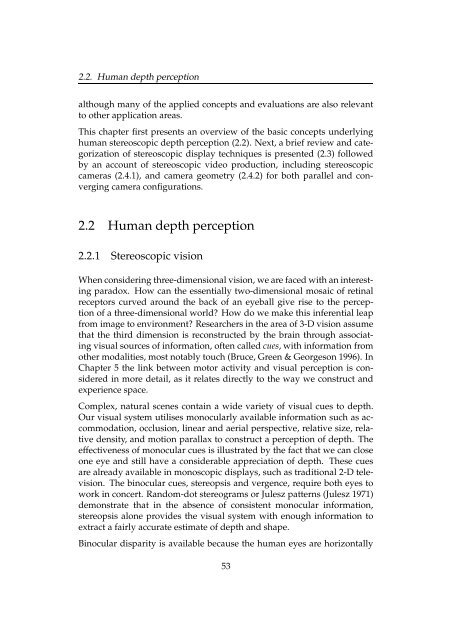Chapter 2 Principles of Stereoscopic Depth Perception and ...
Chapter 2 Principles of Stereoscopic Depth Perception and ...
Chapter 2 Principles of Stereoscopic Depth Perception and ...
Create successful ePaper yourself
Turn your PDF publications into a flip-book with our unique Google optimized e-Paper software.
2.2. Human depth perception<br />
although many <strong>of</strong> the applied concepts <strong>and</strong> evaluations are also relevant<br />
to other application areas.<br />
This chapter first presents an overview <strong>of</strong> the basic concepts underlying<br />
human stereoscopic depth perception (2.2). Next, a brief review <strong>and</strong> categorization<br />
<strong>of</strong> stereoscopic display techniques is presented (2.3) followed<br />
by an account <strong>of</strong> stereoscopic video production, including stereoscopic<br />
cameras (2.4.1), <strong>and</strong> camera geometry (2.4.2) for both parallel <strong>and</strong> converging<br />
camera configurations.<br />
2.2 Human depth perception<br />
2.2.1 <strong>Stereoscopic</strong> vision<br />
When considering three-dimensional vision, we are faced with an interesting<br />
paradox. How can the essentially two-dimensional mosaic <strong>of</strong> retinal<br />
receptors curved around the back <strong>of</strong> an eyeball give rise to the perception<br />
<strong>of</strong> a three-dimensional world How do we make this inferential leap<br />
from image to environment Researchers in the area <strong>of</strong> 3-D vision assume<br />
that the third dimension is reconstructed by the brain through associating<br />
visual sources <strong>of</strong> information, <strong>of</strong>ten called cues, with information from<br />
other modalities, most notably touch (Bruce, Green & Georgeson 1996). In<br />
<strong>Chapter</strong> 5 the link between motor activity <strong>and</strong> visual perception is considered<br />
in more detail, as it relates directly to the way we construct <strong>and</strong><br />
experience space.<br />
Complex, natural scenes contain a wide variety <strong>of</strong> visual cues to depth.<br />
Our visual system utilises monocularly available information such as accommodation,<br />
occlusion, linear <strong>and</strong> aerial perspective, relative size, relative<br />
density, <strong>and</strong> motion parallax to construct a perception <strong>of</strong> depth. The<br />
effectiveness <strong>of</strong> monocular cues is illustrated by the fact that we can close<br />
one eye <strong>and</strong> still have a considerable appreciation <strong>of</strong> depth. These cues<br />
are already available in monoscopic displays, such as traditional 2-D television.<br />
The binocular cues, stereopsis <strong>and</strong> vergence, require both eyes to<br />
work in concert. R<strong>and</strong>om-dot stereograms or Julesz patterns (Julesz 1971)<br />
demonstrate that in the absence <strong>of</strong> consistent monocular information,<br />
stereopsis alone provides the visual system with enough information to<br />
extract a fairly accurate estimate <strong>of</strong> depth <strong>and</strong> shape.<br />
Binocular disparity is available because the human eyes are horizontally<br />
53


